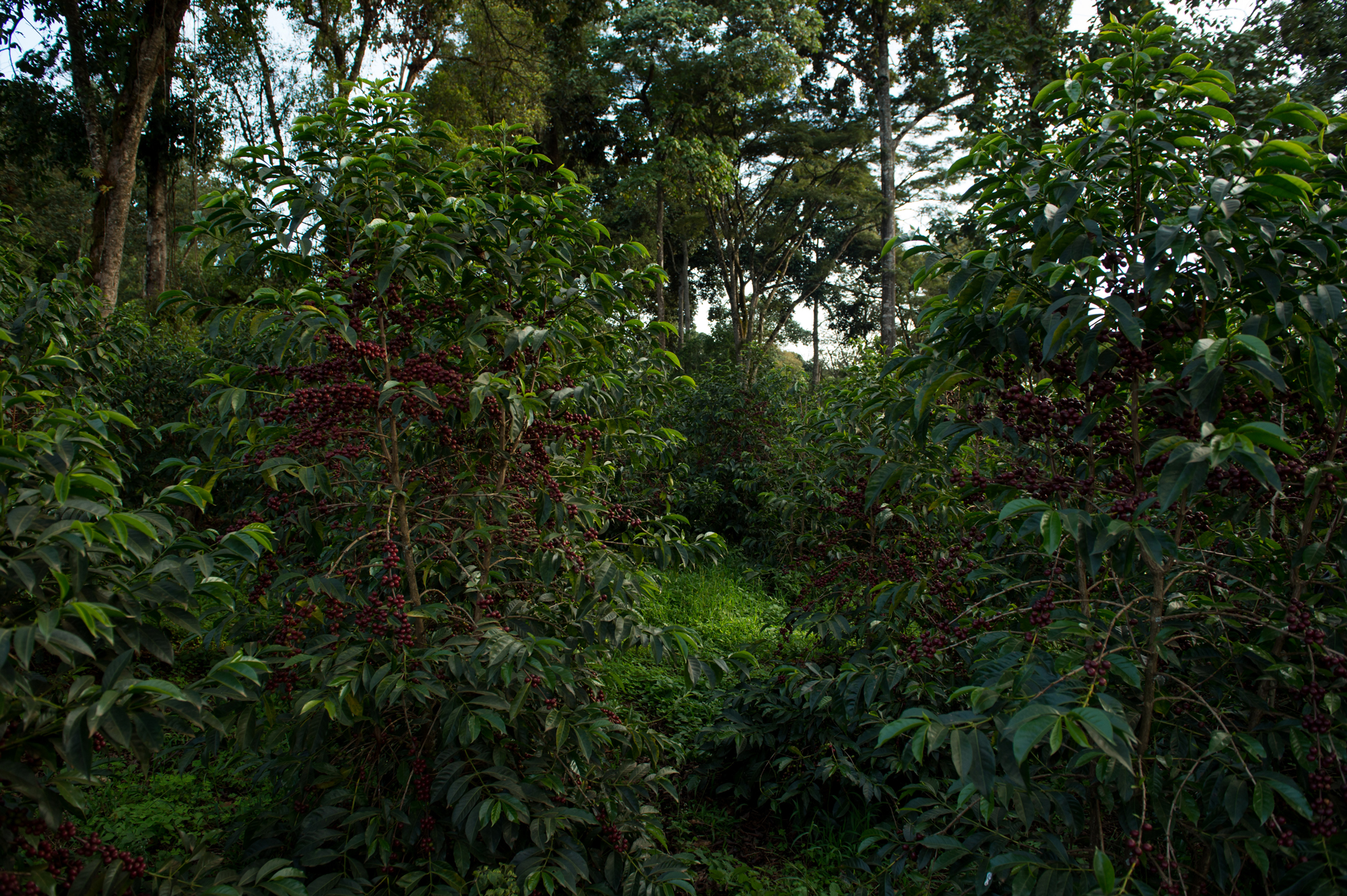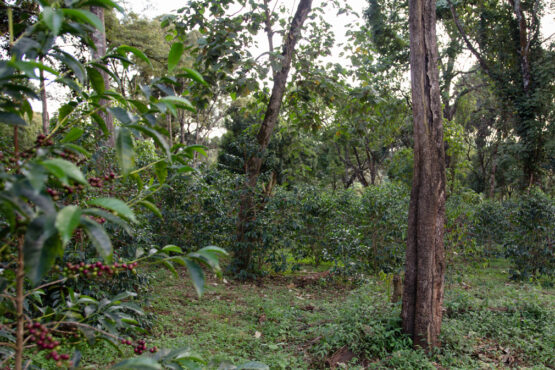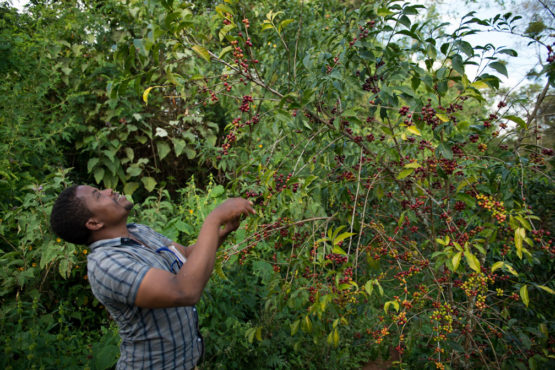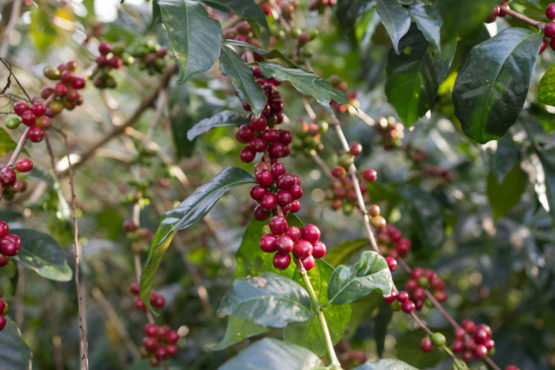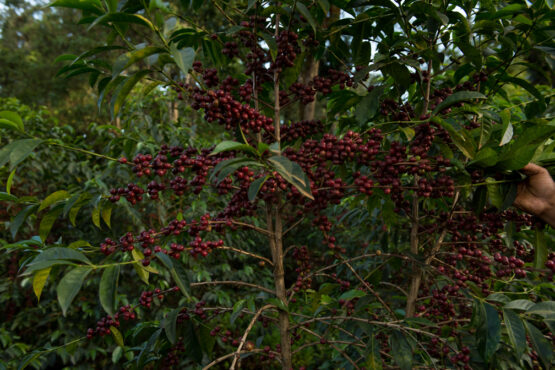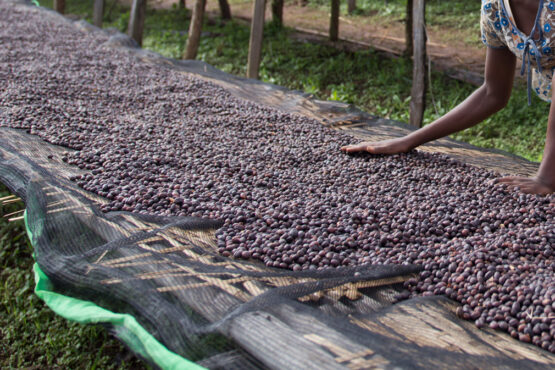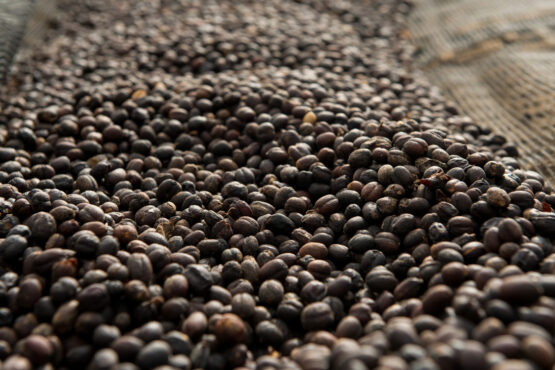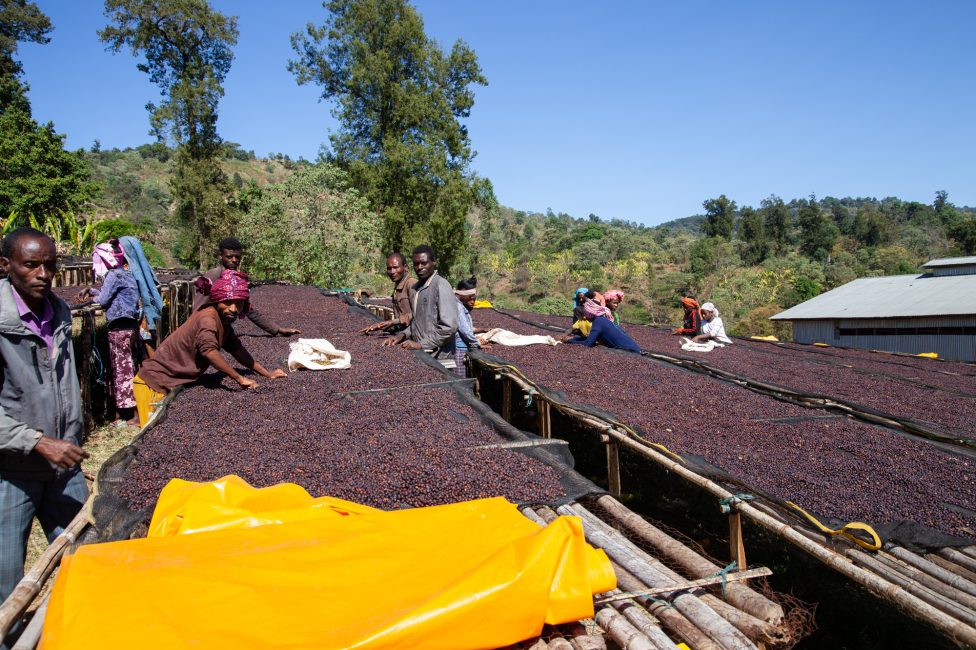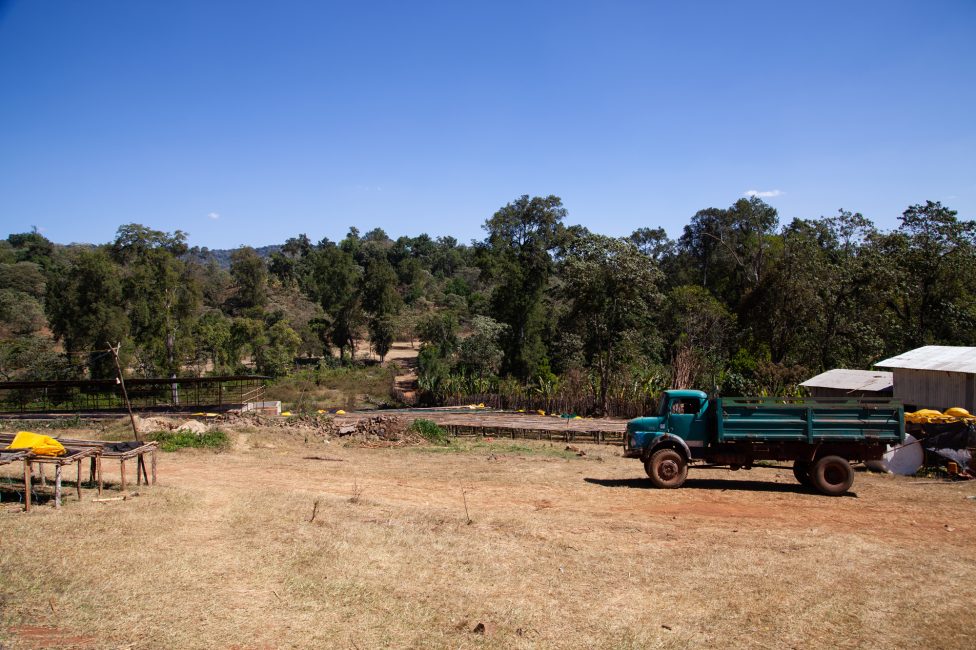Mormora Natural
Abundantly fragrant, with rose, vanilla and chamomile florals. Red grape, peach and kumquat with a juicy body and black tea finish.
Mormora Coffee Plantation is located in the Shakisso ‘woreda’ (administrative district) in the south of the Guji zone of Ethiopia’s Southern Oromia State.
Mormora is owned and managed by Yodesa Yachisi, who purchased the farm in 2008. Yodesa’s background was in mining but when he moved into agriculture in early the 2000s he fell in love with coffee, and its ability to develop and connect communities.
Mormora is located forty-five minutes drive south-west of the town of Shakisso, and sits at an elevation of 1,800–2,100m above sea level. As with most of Ethiopia, agriculture and services are the main form of income for the people, and the short drive from Shakisso to Mormora really highlights it. Every small Oromo hut has a fenced off area growing fava beans, maize, bananas, or chat (a local narcotic plant that is chewed). These small gardens are the cash crops that sustain the income for these families, and it’s critical to their livelihood that these crops produce well every year. Most of the cash crops are sold locally, in the local town or marketplace, or traded at local shops or houses for other goods. Chat and coffee are the two biggest cash crops in this area: chat is able to be harvested more often and doesn’t require as much attention to grow, while coffee gets a better price if it destined for a washing station.
The rich red soil in the areas surrounding Shakisso contains gold, and mining is a big part of life in Shakisso. There are only a handful of commercial mines remaining. These large mines need licenses granted by the government, and in recent years the local communities have pushed back against the mines, mainly due to the feeling that they are not giving back to the communities as much as was promised initially. Much of the gold has been found on the banks of the Mora Mora river, and this is the focus of continued mining activity. Almost the whole surrounding area of Shakisso is dotted with people and families sifting through the red mud of the river for gold.
ABOUT MORMORA FARM
Mormora is a large farm, comprising of 200 hectares, most of which is semi-forest coffee, meaning the forest is managed to allow coffee to grow throughout it. The trees benefit from a mixture of natural shade plants, which—as well as protection from the sun—provide a rich source of leaves and debris which decompose on the forest floor.
Mormora farm is also organic certified (though this particular lot is not), and the land is managed in sections, with the trees undergoing twenty-five year cycles before being stumped to rejuvenate. New trees from their seedling nursery are planted every year. The seeds originate from local heirloom varieties that were collected nearby (that they refer to as the “mother tree”). The family works with local small-holders as well, buying their coffee, and also helping by offering training at the farm level as well as at their mill.
In addition to the 200 hectares that are owned by Yodesa, there are 400 small coffee producers in the area that deliver and sell their coffee to the washing station. These small holders (called “out growers” in Ethiopia) typically have 1–2 hectares of land that produce coffee. At Mormora they are paid in two stages for their coffee, the first when the coffee is dropped off, and then a second time when the overall quality for a certain lot has been determined, and therefore the selling price.
ABOUT THE GUJI REGION
The Guji zone was established as a unique production area in 2002. It is located in the Southern portion of Sidama and is named after the Oromo people: a tribe with a long, proud history in coffee production.
Coffees from Guji were previously classified as ‘Sidama’ (a very wide geographical classification encompassing much of central-south Ethiopia), however more recently they have been separated from this classification and recognised for their unique and distinctive cup profiles. This distinctiveness is driven by the unique combination of elements in this production area, including high altitudes, rich, fertile soil, and exceptional heirloom varieties.
Guji is bordered on the south and west by Borena, on the north by Gedeo and Sidama, and on the east by Bale and the Somali Region. Coffees that are classified as ‘Gujis’, originate from the ‘woreda’ (administrative regions) of Adoola Redi, Uraga, Kercha, Bule Hora, and Shakisso, which is where this lot is from.
Most communities in the region still live rurally and make a living from farming. Coffee remains the major cash crop for most families in the Guji region, who grow coffee alongside food for consumption.
ABOUT THE SIDAMA ZONE
Sidama is a wide geographical classification which encompasses much of central-south Ethiopia and includes renowned coffee producing localities such as Yirgacheffe, Kochere, West Arsi, Bensa and Guji. Sidama is located in Ethiopia’s South East Coffee Zone, extending across the states of Southern Oromia and the Southern Nations, Nationalities, and People’s Region (SNNPR), one of nine ethnically based regional states of Ethiopia. The Sidama zone is named for the Sidama people; a tribe with a long and proud history of coffee production. After a 2019 Referendum, the Sidama zone has separated from the SNNPR and become the autonomous Sidama Region.
Sidama is a renowned coffee area and produces exceptional natural and washed coffees that showcase an extremely diverse range of flavour profiles. Coffees from Sidama are noted for their intensely fruit-forward, tea-like, floral and complex character and are sought after worldwide. It is widely accepted that the coffee species, Arabica, originated in the lush forests of southern forests of Ethiopia and hence growing conditions in this area are perfectly suited for producing exquisite coffees.
Coffee has been cultivated in the Sidama Zone for centuries and is an important source of income for rural households, who grow it as the primary cash crop. Family plots are small and intensively farmed with intercropped coffee, food crops like pulses, grain and yams, and other cash crops like khat (similar to tobacco) and Ethiopian banana. Most farms are planted amongst or alongside indigenous forest trees, which provide a thick canopy of shade for the coffee trees. Historically, farmers in this area will use organic farming practices (although it is unlikely to be certified) as there is no ready access to artificial fertilisers or pesticides.
VARIETY
For many years, most Ethiopian coffee has only been described as being a mix of varieties that we refer to as “heirloom varieties.” This is a term that is all-encompassing and used by many actors in the coffee industry to generally categorise Ethiopian coffee varieties that are from native forest origins. Whilst this describes many of the varieties found in Ethiopia, it is also a bit simplistic and does not acknowledge the varieties that are already locally recognised and cultivated, or those that have been specifically developed and widely distributed by the Jimma Agricultural Research Centre (JARC).
This coffee is made up of two of those JARC varieties, 74110 and 74112. These are grown for disease and pest resistance, rather than only for cup profile, and are released by number. For example, 74110, 74112 and 74116 are all widely propagated in the Sidama growing region. Along with these, Ethiopia is also home to many native or “landrace” varieties in the region that were originally selected from the forest and have been propagated in the Sidama region for decades. There are five popular ones that all have been named after indigenous trees in the area—they are Bedessa, Kudhumi, Mique, Sawe and Walichu. There is little documentation on the history of these varieties, and it is hard to know if they represent single varieties or a wider group of varieties, however, it is widely accepted that they play a major role in the quality of the coffee from this region, with a distinctive floral and citric cup profile.
PROCESSING
This coffee was processed using the natural method; a complex process requiring a high level of attention to detail in order to be done well. Ethiopian coffee has been processed this way by generations of farmers who have mastered the art of the natural method through centuries of tradition and experience.
Mormora take great care in the processing and drying of their naturals, and aim for all of their exportable coffee to be specialty quality. This coffee is classified as Grade 1, indicating that a lot of effort has been put into the selection, grading and drying to ensure the very highest quality coffee is produced.
Each day, carefully hand-picked coffee cherries are delivered to the wet mill and are meticulously hand-sorted prior to processing to remove unripe, overripe, or damaged fruit, in order to enhance the quality and sweetness of the cup.
The coffee is then graded by weight and spread evenly on raised African beds (screens) to sun-dry. Initially, it is laid very thinly and turned regularly to ensure consistent drying and prevent over-fermentation. This is done very carefully to avoid damage to the fruit.
After a few days, when the coffee has reached 25% humidity—this is called the “raisin stage”—the layers of coffee are gradually increased. Careful attention and control during this drying phase ensures the coffee is stable and that a clean and balanced cup profile is achieved. The coffee is turned constantly whilst drying to ensure that it dries evenly and consistently. At midday, the coffee is covered to protect it from full sun. It is also covered overnight to prevent damage from morning dew.
Once the coffee reaches the optimum moisture level (usually after 10 –14 days), it is hulled and rested in bags in parchment until it is ready for export.
WHY WE LOVE IT
It is really special to have a coffee that is traceable back to a single estate from Ethiopia, and Mormora is a stunning example of a single estate coffee from Guji. We have purchased coffee from Mormora every year since 2018 . This year’s natural lot is intensely sweet and floral, with bright citrus acidity and a juicy texture.
